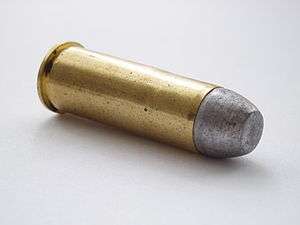.44-40 Winchester
| .44-40 | ||||||||||||||||||||||||
|---|---|---|---|---|---|---|---|---|---|---|---|---|---|---|---|---|---|---|---|---|---|---|---|---|
 .44-40 Winchester cartridge | ||||||||||||||||||||||||
| Type | Rifle/Pistol | |||||||||||||||||||||||
| Place of origin | United States | |||||||||||||||||||||||
| Production history | ||||||||||||||||||||||||
| Designer | Winchester Repeating Arms Company | |||||||||||||||||||||||
| Designed | 1873 | |||||||||||||||||||||||
| Specifications | ||||||||||||||||||||||||
| Bullet diameter | .427 in (10.8 mm) | |||||||||||||||||||||||
| Neck diameter | .443 in (11.3 mm) | |||||||||||||||||||||||
| Shoulder diameter | .457 in (11.6 mm) | |||||||||||||||||||||||
| Base diameter | .471 in (12.0 mm) | |||||||||||||||||||||||
| Rim diameter | .525 in (13.3 mm) | |||||||||||||||||||||||
| Case length | 1.310 in (33.3 mm) | |||||||||||||||||||||||
| Primer type | Large pistol | |||||||||||||||||||||||
| Ballistic performance | ||||||||||||||||||||||||
| ||||||||||||||||||||||||
|
Test barrel length: 20" Source(s): Reloadersnest.com | ||||||||||||||||||||||||
The .44-40 Winchester, also known as .44 Winchester, .44 WCF (Winchester Center Fire), and .44 Largo (in Spanish speaking countries) was introduced in 1873 by the Winchester Repeating Arms Company. It was the first metallic centerfire cartridge manufactured by Winchester, and was promoted as the standard chambering for the new Winchester Model 1873 rifle.[1][2] As both a rifle and a handgun caliber, the cartridge soon became widely popular, so much so that the Winchester Model 1873 rifle became known as "The gun that won the West."[3]
History
When Winchester released the new cartridge, many other firearm companies chambered their guns in the new round. Remington and Marlin released their own rifles and pistols which chambered the round, Colt offered an alternative chambering in its popular Single Action Army revolver in a model known as the Colt Frontier Six-Shooter, and Smith & Wesson began releasing their Smith & Wesson New Model 3 chambered in .44-40. Settlers, lawmen, and cowboys appreciated the convenience of being able to carry a single caliber of ammunition which they could fire in both pistol and rifle. In both law enforcement and hunting usage the .44-40 became the most popular cartridge in the United States and to this day has the reputation of killing more deer than any other save the .30-30 Winchester.[4][5]
The cartridge was originally sold as .44 Winchester. When the Union Metallic Cartridge Co. (U.M.C.) began selling their own version of the cartridge, it adopted the name .44-40 (shorthand for .44 caliber and the standard load at the time of 40 grains (2.6 g) of black powder), as it did not want to offer free advertising for one of its competitors. Over time the name stuck, and eventually Winchester adopted the .44-40 designation for the round after World War II.[6] Winchester uses the designation 44-40 Winchester on packaging.
Technical background
The initial standard load for the cartridge was 40 grains (2.6 g) of black powder propelling a 200-grain (13 g) round nose flat point bullet at approximately 1,245 ft/s (379 m/s). Winchester catalogues listed velocities of 1,300 ft/s (400 m/s) by 1875. In 1886 U.M.C. also began offering a slightly heavier, 217-grain (14.1 g), bullet at 1,190 ft/s (360 m/s), also with 40 grains (2.6 g) of black powder. Winchester soon began to carry the 217-grain (14.1 g) loading as well, but in 1905 U.M.C. discontinued the heavier load. In 1895 Winchester introduced a 200-grain (13 g) cartridge bulk loaded with 17-grain (1.1 g) of DuPont No. 2 Smokeless powder and a bullet for 1,300 ft/s (400 m/s), and in 1896 U.M.C. followed suit with a 217-grain (14.1 g) bullet at 1,235 ft/s (376 m/s) Soon both companies were offering the cartridge with lead "metal patched" (i.e. copper jacketed with lead points), and full metal jacket versions. Taking advantage of the stronger-action designs of the Winchester model 1892 and the Marlin 1894 lever action rifles, in 1903 Winchester began offering a higher performance version of the loading called the W.H.V. (Winchester High Velocity), with a velocity of 1,540 ft/s (470 m/s) with a 200-grain (13 g) copper-jacketed bullet from a 24-inch (610 mm) barrel length, U.M.C. and Peters Cartridge Company soon introduced equivalents. Over the years a number of different bullet weights and styles have been offered, including 122, 140, 160, 165, 166, 180 and 217-grain (14.1 g) in lead, soft- and hollow-point, full metal case, blanks and shotshells. The most common current loading is a 200-grain (13 g) bullet at 1,190 ft/s (360 m/s).[1]
By 1942, more modern cartridges had all but eclipsed the .44-40, but it regained some popularity in the 1950s and 1960s when Colt began once again to manufacture the Single Action Army and Frontier.[7] More recently, the .44-40 has had a resurgence due to the popularity of metallic silhouette and cowboy action shooting, which inspired the introduction of a low-velocity 225-grain (14.6 g) gallery load, the heaviest factory bullet ever available for the cartridge.[1]
See also
References
| Wikimedia Commons has media related to .44-40 Winchester. |
- 1 2 3 "The 44-40 (44WCF) for beginners (like me)" Leverguns Web site.
- ↑ "The .44-40 Winchester" Guns and Ammo Magazine Web site.
- ↑ Madis, George (1971). The Winchester book ([1st ed.] ed.). Lancaster, Tex.: Art and Reference House. ISBN 978-0910156035.
- ↑ Hawks, C. "Early Metallic Cartridges" Chuck Hawks Web site.
- ↑ ".44-40 Winchester" Reloading Bench Web site.
- ↑ Two peas in a pod: Winchester’s .44 W.C.F. & Marlin / U.M.C.‘s .44- 40
- ↑ Taffin J. "Taffin Tests The .44-40 Winchester" Sixguns Web site
